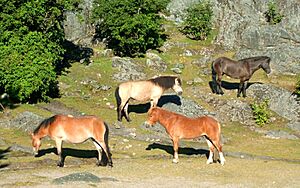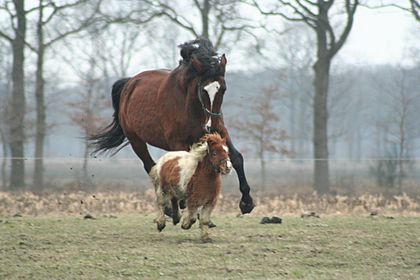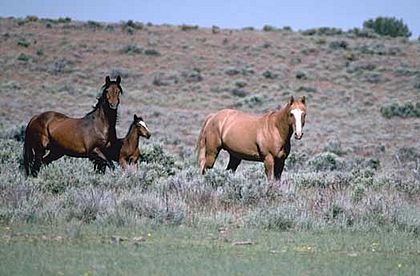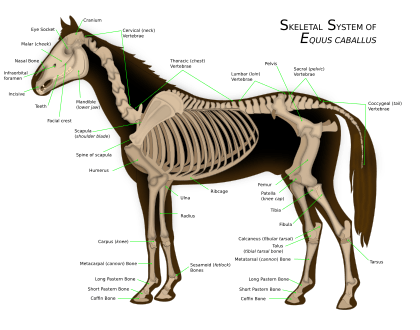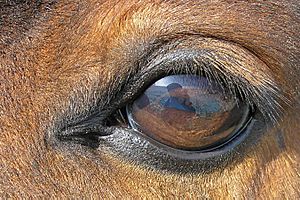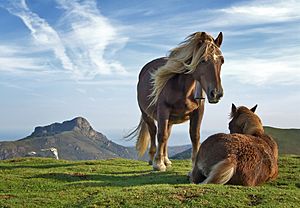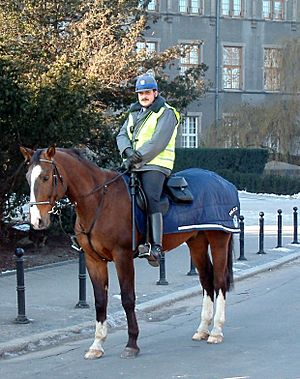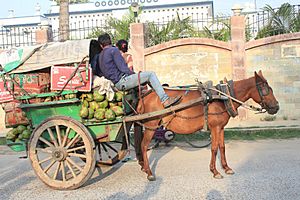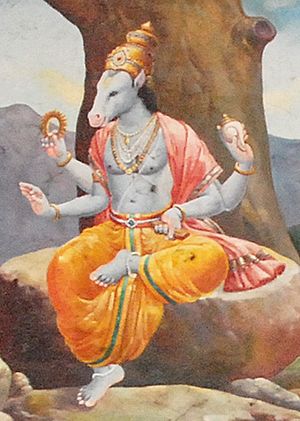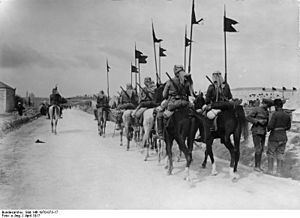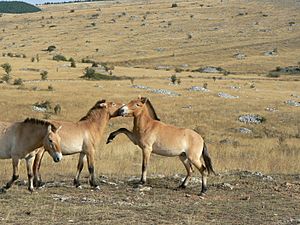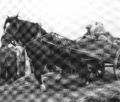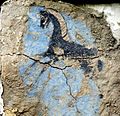Horse facts for kids
Quick facts for kids Horse |
|
|---|---|
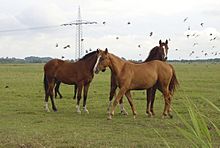 |
|
| Scientific classification | |
| Kingdom: | |
| Class: | |
| Order: | |
| Family: | |
| Genus: | |
| Binomial name | |
| Equus caballus Linnaeus, 1758
|
|
Horses are large, strong mammals that belong to the Equidae family. The common horse we know today is called Equus caballus. Humans started taming wild horses at least 5,000 years ago. Some horse breeds are very strong and can pull heavy loads. Racehorses can run super fast, up to 30 miles per hour!
A male horse is called a stallion, and a female horse is a mare. A young horse is generally called a foal. If it's a young female, it's a filly, and a young male is a colt. A male horse that has been castrated (cannot have babies) is a gelding. Horses have hard hooves on their feet. Sometimes, they need special metal horseshoes to protect their hooves from rough ground.
Contents
- Horse History
- All About Horses
- Other Uses of Horses
- Horse Breeds
- Related pages
- Images for kids
- See also
Horse History
The story of how horses changed over millions of years is very interesting. About 50 million years ago, horses looked very different from how they do now. The earliest horse fossils found in North America are called Eohippus, and those in Europe are called Hyracotherium. Both were small animals. Eohippus was only about twice the size of a small dog.
Over time, these small animals changed a lot. These changes helped them survive as their world changed. They went from living in forests and eating nuts and fruits to eating leaves and small branches. Eventually, modern horses became large animals that live on open grasslands and eat grass. Their teeth, legs, and size changed to help them run fast and chew grass. Big changes happened about 15 million years ago when the weather got colder, and forests turned into grasslands. Many animals, including horses, changed their diets to eat grass.
All About Horses
Horses have special names for their body parts, different ages, colors, and types.
Horse Life Cycle
Domestic horses usually live for 25 to 30 years, but some can live into their 40s. The oldest horse ever recorded was "Old Billy" in the 1800s, who lived to be 62! Another old pony named Sugar Puff lived to be 56.
For most horse competitions, a year is added to a horse's age on January 1st in the Northern Hemisphere and August 1st in the Southern Hemisphere, no matter when they were actually born.
Here are the terms for horses of different ages:
- Foal: A horse of any gender less than one year old. A foal still drinking milk from its mom is a suckling. A foal that has stopped drinking milk is a weanling. Most foals are weaned (stop drinking milk) when they are 5 to 7 months old.
- Yearling: A horse of any gender that is between one and two years old.
- Colt: A male horse under four years old. Remember, this term is only for young males!
- Filly: A female horse under four years old.
- Mare: A female horse that is four years old or older.
- Stallion: A male horse that has not been castrated and is four years old or older.
- Gelding: A male horse that has been castrated (cannot have babies) at any age.
Horse Size and Measurement
Horses are measured from the highest point of their shoulders, called the withers. This spot is used because it's a stable part of their body, unlike their head or neck, which move a lot.
In many English-speaking countries, horse height is measured in "hands" and inches. One hand is equal to 4 inches (about 10 centimeters). So, a horse that is "15.2 h" is 15 hands and 2 inches tall. This means it's 62 inches (about 157 centimeters) tall.
Horses come in many different sizes, depending on their breed and how well they are fed.
- Light riding horses are usually 14 to 16 hands tall and weigh about 380 to 550 kilograms (840 to 1,200 pounds).
- Larger riding horses are often 15.2 to 17 hands tall and weigh 500 to 600 kilograms (1,100 to 1,300 pounds).
- Heavy or draft horses (used for pulling) are usually at least 16 hands tall and can be as tall as 18 hands. They can weigh from 700 to 1,000 kilograms (1,500 to 2,200 pounds).
The biggest horse ever recorded was a Shire horse named Mammoth, born in 1848. He was over 21 hands tall and weighed about 1,524 kilograms (3,360 pounds)! The smallest horse is Thumbelina, a miniature horse with dwarfism. She is only 17 inches (43 centimeters) tall and weighs 57 pounds (26 kilograms).
Ponies
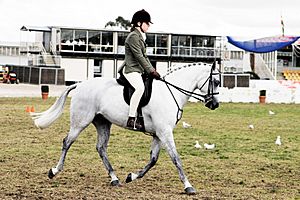
Ponies are actually the same type of animal as horses. The main difference is usually their height. For competitions, a horse is typically 14.2 hands or taller, while a pony is shorter than 14.2 hands. However, it's not just about height. Ponies often have thicker manes, tails, and coats. They also tend to have shorter legs, wider bodies, and shorter, thicker necks. They can be very smart and have calm personalities.
Some horse breeds can have individuals that are shorter than 14.2 hands, but they are still called horses. And some pony breeds might have individuals that grow taller than 14.2 hands, but they are still considered ponies. For example, a Shetland pony is usually about 10 hands tall and is definitely a pony. But a miniature horse, which can be as short as 30 inches (76 centimeters), is classified as a very small horse, not a pony.
Horse Colors and Markings
Horses come in many different colors and have unique markings. People often describe a horse by its color before its breed or gender. White markings on a horse, like a star on its forehead, are inherited separately from its main coat color.
Scientists have found many genes that control horse coat colors and patterns. For example, the basic colors of chestnut (reddish-brown) and black are determined by a specific gene. Other genes create colors like bay (brown body with black mane and tail), or patterns like pinto (large patches of white and another color) or leopard (spots).
Horses that look "white" are usually gray horses. Gray horses are born darker and get lighter as they get older, but they usually have black skin under their white hair. True white horses are rare; they are born with mostly white hair and pink skin. There are no "albino" horses, which would have pink skin and red eyes.
Horse Reproduction and Development
A mare (female horse) is pregnant for about 340 days, which is almost a year! They usually have one foal; twins are very rare. Foals are born ready to stand and run shortly after birth. Most foals are born in the spring. Mares can get pregnant every 19-22 days from spring to autumn. In winter, most mares do not cycle. Foals are usually separated from their mothers (weaned) when they are between four and six months old.
Young male horses (colts) can sometimes reproduce around 18 months old, but horses are usually not allowed to breed until they are at least three years old. Horses are considered fully grown at four years old, but their bones continue to develop until they are about six. Larger horses take longer to fully mature because their bones are bigger.
Depending on their breed and what they will be used for, horses are usually trained to be ridden between two and four years old. For example, Thoroughbred racehorses might start training as young as two, but horses for sports like dressage usually don't start until they are three or four, because their bones and muscles need more time to get strong. For long-distance endurance riding, horses are not allowed to compete until they are five years old.
Horse Anatomy
Horse Skeleton
A horse's skeleton has about 205 bones. One big difference between a horse and a human is that horses don't have a collarbone. Their front legs are connected to their spinal column by strong muscles, tendons, and ligaments.
A horse's legs and hooves are also very special. What we call a horse's "knee" is actually like a human's wrist. The "hock" on their back leg is like a human's ankle and heel. The lower leg bones of a horse are like the bones in a human's hand or foot. The fetlock (often called the "ankle") is like our knuckles. Horses don't have muscles in their legs below the knees and hocks; it's mostly skin, hair, bone, tendons, and ligaments.
Horse Hooves
People say, "no foot, no horse," which means a horse's feet are super important! The horse hoof is made up of bones, cartilage, and other soft tissues inside. The outer hoof wall is made of keratin, the same material as human fingernails. Imagine a horse weighing 500 kilograms (1,100 pounds) walking on what's basically its fingertips! To protect their hooves, especially on hard ground, some horses wear horseshoes. A professional called a farrier puts these on. Hooves grow all the time, so domesticated horses need their hooves trimmed (and horseshoes reset) every 5 to 8 weeks. Wild horses' hooves wear down naturally.
Horse Teeth
Horses are made for eating grass. An adult horse has 12 incisors at the front of its mouth to bite off grass. At the back, they have 24 premolars and molars for chewing. Male horses (stallions and geldings) also have four extra teeth called "tushes" behind their incisors. Some horses might also have small "wolf teeth" in front of their molars, which are usually removed because they can get in the way of the bit (part of the bridle that goes in the horse's mouth). There's an empty space between the front and back teeth where the bit rests.
You can guess a horse's age by looking at its teeth. Horse teeth keep growing throughout their lives and wear down from grazing. So, the incisors change shape and angle as the horse gets older. This gives a rough idea of their age, but what they eat and how they are cared for can also affect how fast their teeth wear down.
Horse Digestion
Horses are herbivores, meaning they only eat plants. Their digestive system is made for eating grass and other plants steadily throughout the day. They have a small stomach but very long intestines to help them get nutrients from their food. A 450-kilogram (1,000-pound) horse will eat about 7 to 11 kilograms (15 to 25 pounds) of food and drink 38 to 45 liters (10 to 12 gallons) of water every day.
Unlike humans, horses can digest cellulose, a main part of grass. They are "hindgut fermenters," meaning special bacteria in their cecum (a part of their large intestine) help break down the cellulose. Horses cannot vomit, so digestive problems can quickly lead to horse colic, which is a serious illness and a common cause of death for horses.
Horse Senses
Horses are prey animals, so their senses are very sharp to help them be aware of danger. They have the largest eyes of any land mammal. Their eyes are on the sides of their heads, giving them a very wide view of over 350 degrees. This means they can see almost all around them! About 65 degrees of their vision is binocular vision (seeing with both eyes, like humans), and the rest is monocular vision (seeing with one eye). Horses have excellent day and night vision. However, they have two-color vision, which is a bit like human red-green color blindness. Red and similar colors might look like shades of green to them.
Their sense of smell is much better than a human's, though not as good as a dog's. Smell helps horses interact with each other and detect things in their environment. They have two ways of smelling: one in their nostrils and nasal cavity for general smells, and another special organ (Jacobson's organ) that mainly detects pheromones (chemical signals).
Horses have good hearing. Each ear can rotate up to 180 degrees, allowing them to hear all around without moving their head. Studies show that horses are calmest in quiet settings or when listening to country or classical music. Loud or certain types of music, like jazz or rock, can make them nervous.
Horses have a great sense of balance. This is partly because they can feel their footing very well and partly because of their strong proprioception (their unconscious sense of where their body and limbs are). Their sense of touch is also very good. The areas around their eyes, ears, and nose are the most sensitive. They can feel something as small as an insect landing on their body.
Horses also have an advanced sense of taste. This helps them pick out the best food from their fodder. Their prehensile lips (lips that can grasp) can easily sort even small grains. Horses usually avoid poisonous plants, but sometimes they might eat them by mistake, even when there's plenty of good food available.
How Horses Move
All horses naturally move in four main ways, called gaits:
- The walk is a four-beat gait (each hoof hits the ground separately) and averages about 6.4 kilometers per hour (4 miles per hour).
- The trot (or jog) is a two-beat gait (diagonal pairs of legs move together) and is faster, about 13 to 19 kilometers per hour (8 to 12 miles per hour).
- The canter (or lope) is a three-beat gait and is about 19 to 24 kilometers per hour (12 to 15 miles per hour).
- The gallop is the fastest gait, averaging 40 to 48 kilometers per hour (25 to 30 miles per hour). The world record for a horse galloping a short distance is 70.76 kilometers per hour (43.97 miles per hour)!
Some horses also have a two-beat pace instead of a trot. There are also several four-beat "ambling" gaits. These are about the same speed as a trot or pace but are much smoother to ride. Examples include the rack, running walk, and tölt. These gaits are often genetic in certain breeds, known as gaited horses.
Horse Behavior
Horses are prey animals, which means they are hunted by other animals. Because of this, they have a strong fight-or-flight response. Their first reaction to danger is usually to get startled and run away. However, if they can't escape or if their young are in danger, they will stand and defend themselves. Horses are also curious. When something startles them, they often pause to figure out what it is before deciding to run. Many riding horses were bred to be fast, agile, alert, and have good stamina, just like their wild ancestors. But some breeds, especially large draft horses, are very calm.
Horses are herd animals, meaning they live in groups. They have a clear pecking order, usually led by a dominant mare. They are social and can form strong friendships with other horses and even with humans. They communicate in different ways, like making sounds (nickering or whinnying), grooming each other, and using body language. Many horses get stressed if they are left alone. With training, horses can learn to see a human as a friend and be comfortable away from other horses. But if they are kept alone without enough exercise or things to do, they might develop bad habits like chewing wood or rocking back and forth.
Horse Intelligence and Learning
Studies show that horses are quite smart. They solve problems every day, like finding food and recognizing other horses in their group. They are also good at understanding space. Horses are naturally curious and like to explore new things. Studies have looked at how horses solve problems, how fast they learn, and how well they remember things. Horses are good at simple learning and can also do more complex things like sorting items into categories. They can learn through different methods, including getting used to things, becoming less sensitive to scary things, and learning from rewards or punishments. One study even showed that horses can tell the difference between "more or less" if the number is small (less than four).
Domesticated horses might face more mental challenges than wild horses. This is because they live in human-made environments that stop them from doing natural behaviors, while also having to learn tasks that aren't natural for them. Horses are creatures of habit and do well with routines. They learn best when the same methods are used consistently. Some trainers believe that "intelligent" horses are a reflection of intelligent trainers who use good training methods and positive rewards that fit the horse's natural way of learning.
Horse Sports
For a long time, people have used horses for games and races. Horse sports were a way to entertain crowds and practice the excellent riding skills needed in battles. Many sports, like dressage, eventing, and show jumping, came from military training, focusing on how well the horse and rider could control themselves and stay balanced. Other sports, like rodeo, came from the practical skills needed on working ranches. Horse racing also started from simple competitions between riders. All these sports require special skills from both horse and rider, which led to the development of specific horse breeds and equipment for each sport. Because equestrian sports have been popular for centuries, the skills needed to ride and work with horses have been kept alive, even after horses were no longer used in wars.
Horses are trained to be ridden or driven in many different sports. Some examples include show jumping (jumping over obstacles), dressage (performing a set of movements), three-day eventing (a mix of dressage, cross-country, and show jumping), combined driving (driving a horse or team of horses pulling a cart through obstacles), endurance riding (long-distance rides), gymkhana (timed games on horseback), rodeos, and fox hunting.
Horse shows are held all over the world. They have many different classes, including riding and driving competitions, as well as "In-hand" classes where horses are led by a person and judged on their body shape. How horses are judged depends on the sport, but winning usually depends on the style and skill of both the horse and rider.
Some sports, like polo, don't judge the horse itself. Instead, the horse is a partner for the human players. Even though the horse needs special training, its performance isn't judged, only the result of the rider's actions, like getting a ball into a goal. Other examples of human-horse partnership sports include jousting, where riders try to unseat each other, and buzkashi, a team game in Central Asia where players try to capture a goat carcass while on horseback.
Horse racing is a huge sport and industry around the world. There are three main types: "flat" racing (running on a flat track); steeplechasing (racing over jumps); and harness racing, where horses trot or pace while pulling a driver in a small cart called a sulky. A big part of horse racing's importance comes from the betting that happens with it.
Horse Work
Some jobs are still best done by horses, and no machine has fully replaced them. For example, mounted police horses are great for patrolling and controlling crowds. On cattle ranches, riders on horseback are still needed to gather cattle spread across rough land. Search and rescue teams in some countries use horses to find people, especially hikers and children, and to help in disasters. Horses can also be used in places where vehicles might damage delicate soil, like nature reserves. They might also be the only way to travel in wilderness areas. Horses are also quieter than motorized vehicles. Law enforcement officers like park rangers might use horses for patrols, and horses or mules can be used for clearing trails in tough terrain where vehicles can't go.
Even though machines have replaced horses in many parts of the world, about 100 million horses, donkeys, and mules are still used for farming and transportation in less developed areas. This includes about 27 million working animals in Africa alone. Some farming and logging tasks can be done very well with horses. Using draft animals like horses in agriculture means less fossil fuel is used and helps protect the environment. Logging with horses can also cause less damage to the soil and trees.
Horse Entertainment and Culture
Today, horses are often used to show how they were used in the past. Horses are part of historical reenactments, where people recreate famous battles or historical periods with accurate equipment. Horses are also used to keep cultural traditions alive and for special ceremonies. Countries like the United Kingdom still use horse-drawn carriages for royalty and important guests at cultural events. Public exhibitions, like the Budweiser Clydesdales (a team of large draft horses pulling a beer wagon), show how horses were used before modern trucks.
Horses are often seen in television, movies, and books. Sometimes they are main characters, and other times they are used to make historical stories look real. Both real horses and images of horses are used in advertising to sell many different products. The horse often appears in coats of arms in heraldry, shown in various poses. The mythologies of many cultures, including Greco-Roman, Hindu, Islamic, and Norse, talk about normal horses and magical ones with wings or extra limbs. Many myths also say that horses pull the chariots of the Moon and Sun. The horse is also one of the 12 animals in the Chinese zodiac.
Horses in Warfare
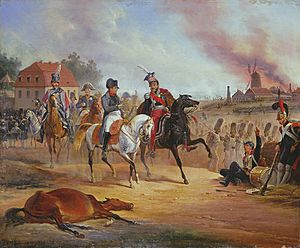
Horses have been used in wars for most of history. The first signs of horses in warfare date back to between 4000 and 3000 BC, and by the end of the Bronze Age, horses were widely used in battles. Even though machines have mostly replaced horses in war, horses are still used in a limited way today. They are mostly for ceremonial purposes, or for scouting and carrying things in rough areas where vehicles can't go.
Other Uses of Horses
Horsehide is a strong leather made from horse skin. Horsehair is used to make stiff fabric or as stuffing for furniture. It can also be mixed with plaster to make it stronger.
Horse bones can be used to make gelatin for food. The bones can also be used to make glue. Some woodworkers still prefer animal glue.
Horses are used all over the world to carry people and pull carts.
They are used by police in big cities. Police horses help police watch and protect people in crowds.
Horse Breeds
Here are some examples of horse breeds:
- Arabian horse
- Exmoor pony
- Friesian
- Lipizzaner
- Thoroughbred
Related pages
- Horse riding – sports with horses
- Pony – for little horses
- Quagga
- Przewalski's Horse
- Donkey (Ass)
- Mule
- Zebra
Images for kids
See also
 In Spanish: Caballo para niños
In Spanish: Caballo para niños


